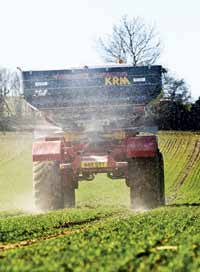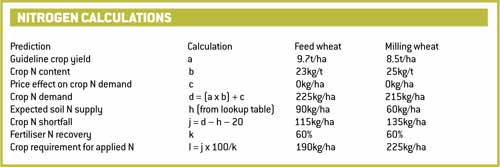New nitrogen guides are put through their paces

The new HGCA booklet ‘Nitrogen for winter wheat – management guidelines’ contains a lot of information on nitrogen use. But how easy is it to use to come up with a recommendation?
To find out Crops asked the guide’s author Roger Sylvester Bradley to last year’s Cereals host farmer Tim Whitehead, who manages Velcourt‘s Vine Farm, near Royston to talk him through the guide and to come up with a recommendation for both his feed and milling wheat crops.
The major difference between the guide and the yet-to-be published Fertiliser Manual and RB209, which the Fertiliser Manual replaces, is that instead of using the familiar look-up tables to find the crop’s nitrogen requirement, it calculates it.
The calculation is done in three parts. First, the crop’s N demand is estimated. From that, controversially for some parts of the industry, the soil N supply is deducted. The shortfall in nitrogen is how much applied N is required, after allowing for the fact that the recovery of applied N – from either fertiliser or manures – is never 100%.
But a key part of the new guidelines is the overall philosophy that N management is both uncertain and often imprecise. Factors, such as soils, varieties, rotations and weather all affect N management, and often the processes affected and their interactions cannot be easily assessed, or accurately predicted.
Therefore it is imperative to review N use after harvest to judge the success of the season’s strategy, and to help shape the following season’s plan.
And that’s where Prof Bradley started with Mr Whitehead: How successful had his N strategy been in the past?
Fortunately Mr Whitehead keeps records of grain protein levels for all his crops, whether it is feed or milling wheat. Grain analysis provided the best indicator of optimal N management, although it was not infallible, Prof Bradley explained.
For feed wheats growers should be looking for around 11% protein content and 12% for breadmaking wheats, although the latter figure is less helpful because breadmaking wheats obviously often receive non-optimal N applications for yield, to boost protein levels to reach the market specification.
In addition, investigations suggest grain analysis is about 70-80% successful in identifying crops that have been over- or under-fertilised with N, so it is better to average results over several fields or years before drawing conclusions.
Mr Whitehead’s figures for the past three seasons were impressive, particularly for feed wheats. The low was 10%, the high 12%, with the vast majority very close to the target figure of 11%, as evidenced by an average of 10.9%.
That suggested there wasn’t too much wrong with his strategy, Prof Bradley said. Generally Mr Whitehead applied 160-190kg/ha of nitrogen to his feed wheats, so what would the guide suggest?
First questions were what grain price was being budgeted for and what price had nitrogen been purchased for? The answers: £110/t for November movement and a mixture of £190/t for ammonium nitrate and £210/t for urea, both bought early in the buying cycle, allowed Prof Bradley to calculate the breakeven ratio for Vine Farm to be close to the 5:1 ratio assumed throughout the guidelines.
It was worth checking the ratio, he said. “But if it is between 3:1 and 8:1 then don’t worry too much about adjusting the crop’s N demand.”
Next up was calculating the crop’s N demand. The guideline suggests in feed wheat 23kg of nitrogen is required per tonne of grain. By multiplying that figure by Vine Farm’s average feed wheat yields of 9.7t/ha, Prof Bradley calculated the crop N demand would be approximately 225kg/ha.
That took care of the first part of the calculation as detailed in Table 12 of the guidelines.
Next was working out the expected soil N supply. Mr Whitehead doesn’t use soil mineral N testing on a regular basis, although some fields had been sampled occasionally.
“For me it is the first point of error,” he told Prof Bradley. There was some truth in the comment, Prof Bradley acknowledged. “It is why we’re involved in a big project currently, which does show there is a lot of variation.”
Some of that was down to how samples were handled. For example, freezing increased the amount of soil mineral N, while the time between sampling and analysis also caused variable results. “There was also variation between labs, at least initially.”
But the project had already highlighted some ground rules growers using testing should follow, he said. “It is best used as a monitoring exercise. Follow indicator fields and be consistent about sampling, who you use to sample, how it is done, which lab is used to help build up a consistent picture.”
Fields that had grown combinable crops for decades without organic manures could be considered to have low soil nitrogen supply, which occasional soil analysis could confirm.
But in other situations more frequent analysis could be useful, he said. The idea is to produce results that are representative of the cropped area and available for any fields with high or uncertain soil nitrogen supply.
“Give priority to fields with known high soil organic matter except peats, fields previously in grass and ones receiving significant amounts of organic manures.”
Fields where effects such as lodging or unexpectedly high grain protein should also be considered, he added.
Prof Bradley would usually use soil mineral N results to calculate the soil nitrogen supply if they were available. “I would always trust the analysis more than a look up table.”
Where soil mineral N is used, the guide explains how to take account of mineralisation during the season, which is only likely to matter where organic matter exceeds 5% in England and Wales, and 10% in Scotland and Northern Ireland.
In addition, the amount of N in the crop when the soil was sampled needs to be taken into account. Table 7 in the guide gives guidance on how to calculate that using plant counts.
Where soil mineral N results are unavailable a crude lookup table is an alternative method of assessing soil nitrogen supply. The left hand column gives a comprehensive list of previous crops and their likely N residues, while along the top of the table run soil types and three categories of excess winter rainfall.
Prof Bradley was able to show Mr Whitehead that his medium soils and a moderate excess rainfall figure for this winter would retain 75% of the approximately 120kg/ha of nitrogen residue from the previous oilseed rape crop, equating to a soil nitrogen supply of 90kg/ha of nitrogen.
That squared well with Mr Whitehead’s assertion that soil mineral N on the farm was always between 60 and 120kg/ha of nitrogen.
The lookup table takes account of mineralisable N so no adjustment needed to be made.
All that was left to do was to calculate the crop N shortfall, by subtracting the 90kg/ha soil nitrogen supply from the 225kg/ha crop N demand, take off another 20kg/ha to allow for N from atmospheric deposition and then divide by the estimated recovery of applied N by the crop.
For most soil types the guide figure is 60%. Sandy or silt soils are higher at 70% recovery, while shallow soils over chalk are estimated to only recover 55% of applied N.
So the final recommendation was 190kg/ha of nitrogen, around the top end of Mr Whitehead’s usual recommendation.
Working through the calculation for Hereward milling wheat (see table) produced a recommendation of 225kg/ha, to which Dr Bradley suggested adding 40kg/ha of N either at the end of May or in July as a foliar spray to boost proteins.
Again this almost exactly mirrored Mr Whitehead’s usual practice. Prior to last year (see panel) milling wheat proteins had typically ranged from 12.9% to 13.2%.
It’s a good guide, Mr Whitehead said afterwards. “It’s going to be a useful management tool to help with N recommendations.”
Disappointing wheats
Milling wheats were a huge disappointment for Mr Whitehead last season. Yields on one field were 2t/ha down on the previous average at just 6.2t/ha, and equally surprising given the low yield, were the 12.4% proteins.
Grown as a second wheat, the yield was compromised by poor autumn establishment and the hot weather in June, Mr Whitehead believed. “The crop was noticeably a bit ‘starey’.”
“To me it suggests there was something wrong early on,” Dr Bradley said. “Probably the rooting for nutrient capture in spring wasn’t good enough. It sounds like it was under-fertilised – you probably needed over 400kg/ha of N because it was so inefficient.”
But that didn’t mean he needed to change too much for this season as previous seasons had been successful. “It might mean you can save money on the following oilseed rape crop because the applied N wasn’t used efficiently.”


